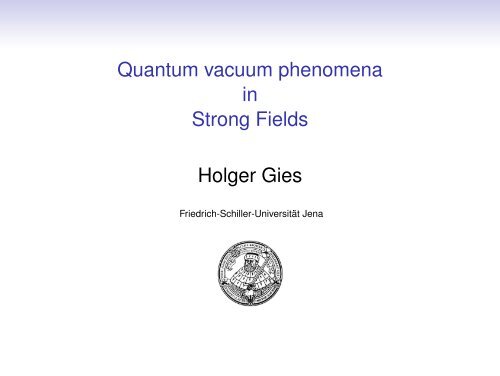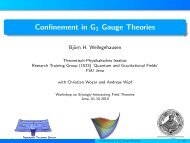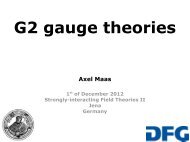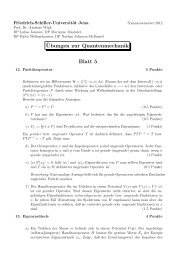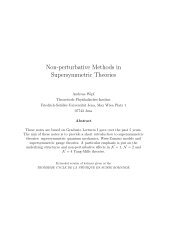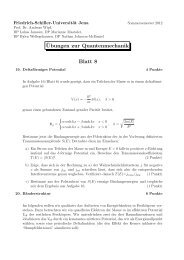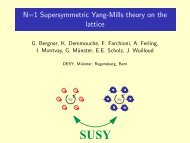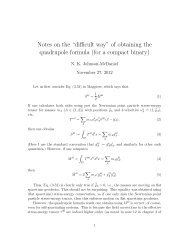Quantum vacuum phenomena in Strong Fields - Friedrich-Schiller ...
Quantum vacuum phenomena in Strong Fields - Friedrich-Schiller ...
Quantum vacuum phenomena in Strong Fields - Friedrich-Schiller ...
Create successful ePaper yourself
Turn your PDF publications into a flip-book with our unique Google optimized e-Paper software.
<strong>Quantum</strong> <strong>vacuum</strong> <strong>phenomena</strong><br />
<strong>in</strong><br />
<strong>Strong</strong> <strong>Fields</strong><br />
Holger Gies<br />
<strong>Friedrich</strong>-<strong>Schiller</strong>-Universität Jena
A view on the quantum <strong>vacuum</strong>.
A view on the quantum <strong>vacuum</strong>.
A view on the quantum <strong>vacuum</strong>.<br />
✄ QFT: quantum fluctuations BUT: . . . just a picture !
A view on the quantum <strong>vacuum</strong>.<br />
✄ External fields: Heisenberg-Euler effective action
A view on the quantum <strong>vacuum</strong>.<br />
=⇒ modified light propagation: “QV ≃ medium” (BFRT,PVLAS,Q&A)<br />
(BMV,OSQAR)
A view on the quantum <strong>vacuum</strong>.<br />
=⇒ modified light propagation: “QV ≃ medium” (POLARIS@JENA)<br />
(HEINZL ET AL.’06)<br />
(B7@SFB-TR18)
A view on the quantum <strong>vacuum</strong><br />
✄ Heat bath: quantum & thermal fluctuations
A view on the quantum <strong>vacuum</strong><br />
✄ Boundary conditions: Casimir effect
+<br />
+<br />
+<br />
+<br />
A view on the quantum <strong>vacuum</strong><br />
e − e+<br />
−<br />
−<br />
−<br />
✄ electric fields: Schw<strong>in</strong>ger pair production<br />
“<strong>vacuum</strong> decay”
Effective action<br />
for the electromagnetized quantum <strong>vacuum</strong>
Light Propagation<br />
✄ classical Maxwell equation <strong>in</strong> vacuo (MAXWELL 1861, 1865)<br />
∫<br />
S = − d 4 x 1 4 F µν F µν =⇒ 0 = ∂ µ F µν<br />
✄ velocity of a plane-wave solution:<br />
v = 1 (= c)<br />
✄ superposition pr<strong>in</strong>ciple<br />
F µν = F µν<br />
1<br />
+ F µν<br />
2<br />
=⇒ no self-<strong>in</strong>teractions
Self-<strong>in</strong>teractions from the <strong>Quantum</strong> Vacuum<br />
M<strong>in</strong>d the e + e − fluctuations
✄ the electron . . .<br />
Electron mass scale<br />
m ≃ 511 keV ≃ 9 · 10 −31 kg<br />
✄ = 1 = c<br />
• E cr ≃ 1.3 · 10 18 Volt/m<br />
• m ≃ 7.6 · 10 11 GHz<br />
• m ≃ 6 · 10 9 Kelv<strong>in</strong><br />
m. . . is very heavy!<br />
• m 2 ≃ 1.3 · 10 9 Tesla
✄ the electron . . .<br />
Electron mass scale<br />
m ≃ 511 keV ≃ 9 · 10 −31 kg<br />
. . . is very heavy!<br />
✄ = 1 = c<br />
• E cr ≃ 1.3 · 10 18 Volt/m<br />
• m ≃ 7.6 · 10 11 GHz<br />
• m ≃ 6 · 10 9 Kelv<strong>in</strong><br />
• m 2 ≃ 1.3 · 10 9 Tesla<br />
I cr ≡ Ecr 2 ≃ 4.4 × 10 29 W/cm 2<br />
=⇒ Polaris: ∼ 1% m<br />
=⇒ ELI: ∼ 25% m<br />
=⇒ U ion: ∼ 138% m
From QED to Nonl<strong>in</strong>ear ED<br />
✄ mass scale m divides quantum fluctuations <strong>in</strong><br />
hard |p 2 | > m 2 soft |p 2 | < m 2<br />
(photons and electrons)<br />
(only photons =EM fields)<br />
Physics of the soft fields:<br />
average over ∫ (<strong>in</strong>tegrate out) hard modes<br />
=⇒ Heisenberg-Euler effective action Γ
✄ <strong>vacuum</strong> energy<br />
Heisenberg-Euler Effective Action<br />
E = 1 2 ω
✄ <strong>vacuum</strong> energy<br />
Heisenberg-Euler Effective Action<br />
E = 1 2 ∑ n<br />
ω n<br />
✄ electron modes<br />
√<br />
ω n = ⃗p 2 + m 2
✄ <strong>vacuum</strong> energy<br />
Heisenberg-Euler Effective Action<br />
E = 1 2 ∑ n<br />
ω n<br />
✄ electron modes<br />
ω n =<br />
√<br />
p 2 ‖ + m2 + eB(2n + 1 ± 1)
✄ <strong>vacuum</strong> energy<br />
Heisenberg-Euler Effective Action<br />
E = 1 2 ∑ n<br />
ω n<br />
✄ electron modes<br />
ω n =<br />
√<br />
p 2 ‖ + m2 + eB(2n + 1 ± 1)<br />
✄ Heisenberg-Euler effective action Γ<br />
(HEISENBERG& EULER’36; WEISSKOPF’36)<br />
Γ 1<br />
(<br />
ωn (B) − ω n (B = 0) )<br />
= −∆E(B) = − 1 L t 2 ∑ n<br />
∫<br />
1 ∞<br />
( )<br />
ds s eBs<br />
=<br />
8π 2 0 s 3 e−m2 tanh eBs − 1<br />
(unrenormalized)
Heisenberg-Euler Effective Action<br />
✄ <strong>vacuum</strong> energy<br />
E = 1 2 ∑ n<br />
✄ electric fields<br />
B → iE<br />
ω n<br />
+<br />
+<br />
+<br />
+<br />
e − e+<br />
−<br />
−<br />
−<br />
✄ Heisenberg-Euler effective action Γ<br />
Γ 1<br />
L t<br />
=<br />
∫<br />
1 ∞<br />
( )<br />
ds s eEs<br />
8π 2 0 s 3 e−m2 tan eEs − 1<br />
(HEISENBERG& EULER’36; WEISSKOPF’36)<br />
(unrenormalized)<br />
=⇒ ImΓ[E] ≠ 0 (SAUTER’31)<br />
✄ <strong>vacuum</strong> persistence probability:<br />
( )<br />
P = exp − 2 ImΓ
Heisenberg-Euler Effective Action.<br />
(EULER, KOCKEL’35; HEISENBERG, EULER’36; WEISSKOPF’36; SCHWINGER’51; RITUS’76)<br />
Γ = +<br />
1%<br />
+ + . . .<br />
∫<br />
= − F + 1<br />
x<br />
8π 2 ∫x<br />
∫ [ ds<br />
√F<br />
s<br />
s e−im2 (es) 2 |G| cot(es√<br />
2<br />
+G 2 +F)<br />
√F<br />
]<br />
× coth(es√<br />
2<br />
+G 2 −F) . . .<br />
Conventions: F = 1 4 F µνF µν = 1 2 (B2 − E 2 ), G = 1 4 F µν ˜F µν = −B · E
Heisenberg-Euler Effective Action.<br />
(EULER, KOCKEL’35; HEISENBERG, EULER’36; WEISSKOPF’36; SCHWINGER’51; RITUS’76)<br />
✄ weak-field expansion<br />
∫ {<br />
Γ = −F + 8 α 2<br />
45 m 4 F 2 + 14 α 2<br />
45 m 4 G2 + O(F 6 )<br />
}<br />
= + + . . .<br />
Conventions: F = 1 4 F µνF µν = 1 2 (B2 − E 2 ), G = 1 4 F µν ˜F µν = −B · E
Light Propagation.<br />
✄ classical Maxwell equation <strong>in</strong> vacuo (MAXWELL 1861, 1865)<br />
0 = ∂ µ F µν<br />
✄ velocity of a plane-wave solution:<br />
v = 1 (= c)
Light Propagation <strong>in</strong> a B field.<br />
✄ quantum Maxwell equation<br />
(<br />
0 = ∂ µ F µν − 1 8 α 2<br />
2 45 m 4 F αβ F αβ F µν − 1 14 α 2<br />
)<br />
2 45 m 4 F αβ µν<br />
F αβ ˜F<br />
(HEISENBERG,EULER’36;WEISSKOPF’36)
Light Propagation <strong>in</strong> a B field.<br />
✄ quantum Maxwell equation for a “light probe” f µν<br />
α 2<br />
0 = ∂ µ f µν − 8<br />
45 m 4 F αβF µν ∂ µ f αβ − 14<br />
45 m ˜F 4 αβ ˜F µν ∂ µ f αβ<br />
Phase and group velocity<br />
α 2<br />
α 2<br />
v ‖ ≃ 1 − 14<br />
45 m 4 B2 s<strong>in</strong> 2 θ B<br />
v ⊥ ≃ 1 − 8 α 2<br />
45 m 4 B2 s<strong>in</strong> 2 θ B<br />
(TOLL’54)<br />
(BAIER,BREITENLOHNER’67;NAROZHNIY’69)<br />
(BIALYNICKA-BIRULA,BIALYNICKI-BIRULA’70)<br />
(ADLER’71)<br />
=⇒ magnetized quantum <strong>vacuum</strong> <strong>in</strong>duces birefr<strong>in</strong>gence<br />
✄ detection schemes:<br />
PVLAS, BMV, Q&A, OSQAR, TR18-B7
Light Propagation <strong>in</strong> a B field.<br />
✄ observable: birefr<strong>in</strong>gence <strong>in</strong>duces ellipticity<br />
||<br />
✄ ellipticity:<br />
B<br />
∆φ = π L ∆v s<strong>in</strong> 2θ,<br />
λ<br />
∆v(5.5T) ≃ 10−22
<strong>Quantum</strong> Vacuum@Jena<br />
✄ birefr<strong>in</strong>gence at a photon collider (HEINZL,LIESFELD,AMTHOR,SCHWOERER,SAUERBREY,WIPF’06)<br />
✄ high-<strong>in</strong>tensity laser<br />
(SFB-TR18-PROPOSAL: HG,KALUZA,WIPF,PAULUS’08)<br />
[WIPF@JENA]
Birefr<strong>in</strong>gence@Jena<br />
✄ back-scattered Thomson photons<br />
✄ <strong>in</strong>tensity<br />
(KOCH,HEINZL,WIPF’05)<br />
ω ≃ 2 × 10 −3 m<br />
I = 2×10 −8 I cr ≃ 10 22 W/cm 2<br />
✄ parameters (ω <strong>in</strong> keV, λ <strong>in</strong> nm, z 0 <strong>in</strong> µm)<br />
✄ <strong>vacuum</strong>: pre-pulse?<br />
ω λ L ∆φ (rad)<br />
Polaris 1 1.2 10 1.2 × 10 −6<br />
12 0.1 10 1.4 × 10 −5<br />
XFEL 15 0.08 25 4.4 × 10 −5<br />
✄ x-ray optics, <strong>in</strong> pr<strong>in</strong>ciple ∆φ ≃ 6 × 10 −6 ?<br />
(ALP ET AL.’00)
<strong>Quantum</strong> <strong>vacuum</strong>
+<br />
+<br />
+<br />
+<br />
<strong>Quantum</strong> <strong>vacuum</strong><br />
e − e+<br />
−<br />
−<br />
−<br />
✄ electric fields: Schw<strong>in</strong>ger pair production<br />
“<strong>vacuum</strong> decay”
Schw<strong>in</strong>ger pair production<br />
(SAUTER’31; HEISENBERG,EULER’36; SCHWINGER’51)<br />
+<br />
+<br />
+<br />
+<br />
e − e+<br />
−<br />
−<br />
✄ production rate<br />
( )<br />
W = (eE)2<br />
4π 3 exp − m2 π<br />
e E<br />
(E cr = m2<br />
e )<br />
“nonperturbative” phenomenon
Schw<strong>in</strong>ger pair production<br />
✄ e.g., pair production <strong>in</strong> RF cavities<br />
E ≃ 100 MV/m<br />
Vol ≃ 1 m 3<br />
✄ <strong>vacuum</strong> decay time ⇔ production time of 1 pair:
Schw<strong>in</strong>ger pair production<br />
✄ e.g., pair production <strong>in</strong> RF cavities<br />
E ≃ 100 MV/m<br />
Vol ≃ 1 m 3<br />
✄ <strong>vacuum</strong> decay time ⇔ production time of 1 pair:<br />
τ ∼ 10 5000000000 s
Pair Production as Tunnel<strong>in</strong>g<br />
✄ cf. atomic ionization as tunnel<strong>in</strong>g:<br />
(OPPENHEIMER’29)<br />
P ∼ exp<br />
∼<br />
[<br />
− 4 3<br />
[<br />
exp − 2 3<br />
√<br />
3/2 2m E<br />
b<br />
eE<br />
m 2 e 6<br />
eE<br />
]<br />
]<br />
✄ pair production as tunnel<strong>in</strong>g:<br />
]<br />
P ∼ exp<br />
[− πm2<br />
eE<br />
[<br />
∼ exp − 2 m 2 e 6<br />
3 eE<br />
× 3π ]<br />
2α 3<br />
(SAUTER’31; HEISENBERG,EULER’36)<br />
E b = 2m<br />
factor ∼ 10 7
Schw<strong>in</strong>ger Pair Production?<br />
• Are there mechanisms to enhance pair production?<br />
. . . nonperturbative QFT, ∼ Hawk<strong>in</strong>g radition . . .<br />
• E fields with spatial and temporal <strong>in</strong>homogeneities?<br />
. . . quantum energies, Casimir <strong>phenomena</strong> . . .<br />
• Real-time evolution and momentum distributions?<br />
. . . non-equilibrium QFT: early universe, HIC, baryogenesis . . .
Inhomogeneous <strong>Fields</strong>
Effective action Γ <strong>in</strong> <strong>in</strong>homogeneous fields<br />
Remember . . .<br />
✄ quantum energies E = 1 2<br />
∑<br />
n ω n[A],<br />
E = Γ T<br />
✄ effective action:<br />
Γ[A] =<br />
Problem solved, “<strong>in</strong> pr<strong>in</strong>ciple”<br />
• f<strong>in</strong>d spectrum ω n [A] for a given background A<br />
• sum over spectrum
Effective action Γ <strong>in</strong> <strong>in</strong>homogeneous fields<br />
Γ[A] =<br />
T ∑<br />
2<br />
n<br />
ω n [A] =<br />
In general practice:<br />
BUT:<br />
• spectrum {ω n [A]} not known<br />
analytically<br />
• spectrum {ω n [A]} not bounded<br />
• ∑ n → ∞ (regularization)<br />
• renormalization
Effective action Γ <strong>in</strong> <strong>in</strong>homogeneous fields<br />
Γ[A] =<br />
T ∑<br />
2<br />
n<br />
ω n [A] =<br />
In general practice:<br />
BUT:<br />
• spectrum {ω n [A]} not known<br />
analytically<br />
• spectrum {ω n [A]} not bounded<br />
• ∑ n → ∞ (regularization)<br />
• renormalization
Worldl<strong>in</strong>e representation of Γ<br />
Γ[A]<br />
∫ ∞<br />
dT<br />
= −<br />
T e−m2T<br />
1/Λ 2<br />
∫<br />
N<br />
x(T )=x(0)<br />
TR<br />
Dx(τ) e − 0<br />
”<br />
“ẋ2 dτ 4 +ie ẋ·A(xτ)<br />
(FEYNMAN’50)<br />
(BERN&KOSOWER’92; STRASSLER’92)<br />
x(T ) =<br />
(SCHMIDT&SCHUBERT’93)<br />
(HG&LANGFELD’01)<br />
Worldl<strong>in</strong>e approach:<br />
• effective action Γ ∼ ∫ closed worldl<strong>in</strong>es x(τ)<br />
• worldl<strong>in</strong>e ∼ spacetime trajectory of φ fluctuations<br />
• gauge-field <strong>in</strong>teraction ∼ “Wegner-Wilson loop”<br />
• f<strong>in</strong>d<strong>in</strong>g {ω n [A]} and ∑ n<br />
done <strong>in</strong> one f<strong>in</strong>ite (numerical) step
Trajectory of a <strong>Quantum</strong> Fluctuation.<br />
✄ Feynman diagram (conventionally <strong>in</strong> momentum space)
Trajectory of a <strong>Quantum</strong> Fluctuation.<br />
✄ worldl<strong>in</strong>e (artist’s view)
Trajectory of a <strong>Quantum</strong> Fluctuation.<br />
✄ worldl<strong>in</strong>e numerics:<br />
N = 4 po<strong>in</strong>ts per loop (ppl)
Trajectory of a <strong>Quantum</strong> Fluctuation.<br />
✄ worldl<strong>in</strong>e numerics:<br />
N = 10 po<strong>in</strong>ts per loop (ppl)
Trajectory of a <strong>Quantum</strong> Fluctuation.<br />
✄ worldl<strong>in</strong>e numerics:<br />
N = 40 po<strong>in</strong>ts per loop (ppl)
Trajectory of a <strong>Quantum</strong> Fluctuation.<br />
✄ worldl<strong>in</strong>e numerics:<br />
N = 100 po<strong>in</strong>ts per loop (ppl)
Trajectory of a <strong>Quantum</strong> Fluctuation.<br />
✄ worldl<strong>in</strong>e numerics:<br />
N = 1000 po<strong>in</strong>ts per loop (ppl)
Trajectory of a <strong>Quantum</strong> Fluctuation.<br />
✄ worldl<strong>in</strong>e numerics:<br />
N = 10000 po<strong>in</strong>ts per loop (ppl)
Trajectory of a <strong>Quantum</strong> Fluctuation.<br />
✄ worldl<strong>in</strong>e numerics:<br />
N = 100000 po<strong>in</strong>ts per loop (ppl)
+<br />
+<br />
+<br />
+<br />
<strong>Quantum</strong> <strong>vacuum</strong><br />
e − e+<br />
−<br />
−<br />
−<br />
✄ electric fields: Schw<strong>in</strong>ger pair production<br />
“<strong>vacuum</strong> decay”
✄ worldl<strong>in</strong>e picture<br />
Schw<strong>in</strong>ger pair production<br />
(HG,KLINGMULLER’05)
✄ worldl<strong>in</strong>e picture<br />
Schw<strong>in</strong>ger pair production<br />
(HG,KLINGMULLER’05)<br />
e E L ∼ m<br />
+<br />
+<br />
+<br />
+<br />
e − + e L<br />
−<br />
−<br />
−
✄ worldl<strong>in</strong>e picture<br />
Schw<strong>in</strong>ger pair production<br />
(HG,KLINGMULLER’05)<br />
+<br />
+<br />
+<br />
+<br />
e − +<br />
L<br />
e<br />
−<br />
−<br />
−<br />
L ∼ 1 m :<br />
E cr = m2<br />
e<br />
≃ 1.3 × 1018 V/m
e + e − pair production<br />
✄ Pair production requires delocalization !<br />
e−<br />
e+<br />
∫<br />
e<br />
ds · E > 2m
e + e − pair production<br />
✄ e.g., a localized field E ∼ sech 2 kx:
e + e − pair production<br />
✄ e.g., a localized field E ∼ sech 2 kx:<br />
e−<br />
e+
e + e − pair production<br />
✄ e.g., a localized field E ∼ sech 2 kx:
e + e − pair production<br />
✄ e.g., a localized field E ∼ sech 2 kx:
e + e − pair production<br />
✄ e.g., a localized field E ∼ sech 2 kx:<br />
(NIKISHOV’70; HG,KLINGMÜLLER’05; DUNNE,HG,WANG,SCHUBERT’05)<br />
ImΓ<br />
ImΓ LCF<br />
mk<br />
eE
e + e − pair production<br />
✄ s<strong>in</strong>e-modulated field: E(x) = E 0 + E 1 s<strong>in</strong> kx<br />
k x
e + e − pair production<br />
✄ s<strong>in</strong>e-modulated field: E(x) = E 0 + E 1 s<strong>in</strong> kx
e + e − pair production<br />
✄ s<strong>in</strong>e-modulated field: E(x) = E 0 + E 1 s<strong>in</strong> kx
e + e − pair production<br />
✄ s<strong>in</strong>e-modulated field: E(x) = E 0 + E 1 s<strong>in</strong> kx<br />
1e-10<br />
0.4<br />
0.35<br />
0.3<br />
|ImLeff|/m 4<br />
1e-11<br />
0.25<br />
0.2<br />
0.15<br />
E/ m2<br />
e<br />
1e-12<br />
0<br />
1<br />
2<br />
ImL eff<br />
E<br />
ImL eff , constant field limit<br />
3 4<br />
x 1 m<br />
5<br />
6<br />
0.1<br />
0.05<br />
0
e + e − pair production<br />
✄ s<strong>in</strong>e-modulated field: E(x) = E 0 + E 1 s<strong>in</strong> kx
e + e − pair production<br />
✄ s<strong>in</strong>e-modulated field: E(x) = E 0 + E 1 s<strong>in</strong> kx
e + e − pair production<br />
Pair production <strong>in</strong> spatially <strong>in</strong>homogeneous fields:<br />
• slowly vary<strong>in</strong>g fields, k ≪ m:<br />
∫<br />
ImΓ = d 4 xImL Schw<strong>in</strong>ger (E(x))<br />
• rapidly vary<strong>in</strong>g fields, k ≫ m:<br />
ImΓ = ImΓ Schw<strong>in</strong>ger (Ē),<br />
Ē = 1 V<br />
∫<br />
d 3 x E(x)
Pair Production with Taylored Pulses<br />
✄ how to beat τ ∼ 10 5000000000 s . . . ?<br />
(SCHÜTZHOLD,HG,DUNNE’08)<br />
✄ temporal <strong>in</strong>homogeneities at frequency ω<br />
=⇒ dynamically assisted pair production
Pair Production with Taylored Pulses<br />
✄ slow strong field E(Ω) + fast weak wiggles ɛ(ω)<br />
(SCHÜTZHOLD,HG,DUNNE’08)<br />
✄ Schw<strong>in</strong>ger exponent:<br />
m2 −π<br />
e eE<br />
comb<strong>in</strong>ed Keldysh parameter: γ = mω<br />
eE
Real-Time Evolution
Real-time evolution of pair production<br />
✄ one-loop QED → quantum k<strong>in</strong>etic equation<br />
(SMOLYANSKY ET AL’97; KLUGER,MOTTOLA,EISENBERG’98;SCHMIDT ET AL’98)<br />
df ( ⃗ k, t)<br />
dt<br />
= 1 eE(t)ɛ ⊥<br />
2 ω 2 ( ⃗ k, t)<br />
∫ t<br />
−∞<br />
⎡<br />
⎤<br />
dt ′ eE(t ′ )ɛ<br />
[<br />
⊥<br />
ω 2 ( ⃗ 1 − 2f ( ⃗ ] ∫ t<br />
k, t ′ ) cos ⎣2 dτ ω( ⃗ k, τ) ⎦<br />
k, t ′ )<br />
t ′<br />
where<br />
ɛ 2 ⊥ = m 2 + k⊥, 2 ω 2 = ɛ 2 ⊥ + [k 3 − eA(t)] 2<br />
• non-Markovian (memory effects)<br />
• statistics (Pauli block<strong>in</strong>g)<br />
• back-reactions can be <strong>in</strong>cluded (BLOCH ET AL.’99)
e + e − pair production<br />
(NIKISHOV’70; DUNNE,HALL’98; HEBENSTREIT,ALKOFER,HG’08)<br />
✄ e.g., a temporally localized field E ∼ sech 2 t τ :<br />
510 5<br />
<br />
<br />
number densitynm 3 <br />
110 5<br />
510 6<br />
110 6<br />
510 7<br />
110 7<br />
<br />
<br />
<br />
<br />
<br />
<br />
<br />
<br />
<br />
<br />
<br />
<br />
1 2 3 4 5 6 7 8 9 10<br />
Τ2⨯10 5 eV 1 <br />
<br />
<br />
<br />
<br />
<br />
<br />
<br />
<br />
enhancement for<br />
γ =<br />
m<br />
τeE ∼ 1<br />
Keldysh parameter
Real-time evolution of pair production<br />
✄ particle density n: virtual excitations vs. asymptotic real pairs<br />
(e.g., E = 0.1E cr , τ = 2 × 10 −5 eV −1 , k ⊥ = 0):<br />
n<br />
[nm 3 ]
Real-time evolution of pair production<br />
✄ particle density n: virtual excitations vs. asymptotic real pairs<br />
(e.g., E = 0.1E cr , τ = 2 × 10 −5 eV −1 , k ⊥ = 0):<br />
n<br />
[nm 3 ]
Real-time evolution of pair production<br />
✄ particle density n: virtual excitations vs. asymptotic real pairs<br />
(e.g., E = 0.1E cr , τ = 2 × 10 −5 eV −1 , k ⊥ = 0):<br />
n<br />
[nm 3 ]
Real-time evolution of pair production<br />
✄ particle density n: virtual excitations vs. asymptotic real pairs<br />
(e.g., E = 0.1E cr , τ = 2 × 10 −5 eV −1 , k ⊥ = 0):<br />
n<br />
[nm 3 ]
Real-time evolution of pair production<br />
✄ particle density n: virtual excitations vs. asymptotic real pairs<br />
(e.g., E = 0.1E cr , τ = 2 × 10 −5 eV −1 , k ⊥ = 0):<br />
n<br />
[nm 3 ]
Real-time evolution of pair production<br />
✄ particle density n: virtual excitations vs. asymptotic real pairs<br />
(e.g., E = 0.1E cr , τ = 2 × 10 −5 eV −1 , k ⊥ = 0):<br />
n<br />
[nm 3 ]
Real-time evolution of pair production<br />
✄ particle density n: virtual excitations vs. asymptotic real pairs<br />
(e.g., E = 0.1E cr , τ = 2 × 10 −5 eV −1 , k ⊥ = 0):<br />
n<br />
[nm 3 ]
Real-time evolution of pair production<br />
✄ particle density n: virtual excitations vs. asymptotic real pairs<br />
(e.g., E = 0.1E cr , τ = 2 × 10 −5 eV −1 , k ⊥ = 0):<br />
n<br />
[nm 3 ]
Real-time evolution of pair production<br />
✄ particle density n: virtual excitations vs. asymptotic real pairs<br />
(e.g., E = 0.1E cr , τ = 2 × 10 −5 eV −1 , k ⊥ = 0):<br />
n<br />
[nm 3 ]
Real-time evolution of pair production<br />
✄ particle density n: virtual excitations vs. asymptotic real pairs<br />
(e.g., E = 0.1E cr , τ = 2 × 10 −5 eV −1 , k ⊥ = 0):<br />
n<br />
[nm 3 ]
Real-time evolution of pair production<br />
✄ particle density n: virtual excitations vs. asymptotic real pairs<br />
(e.g., E = 0.1E cr , τ = 2 × 10 −5 eV −1 , k ⊥ = 0):<br />
n<br />
[nm 3 ]<br />
4⨯10 12<br />
2⨯10 12<br />
0.2<br />
0<br />
0.4<br />
p MeV<br />
0.6<br />
200<br />
100<br />
k ⊥ keV<br />
0.8<br />
300
Why quantum <strong>vacuum</strong> physics?<br />
• Heisenberg-Euler/Casimir <strong>in</strong><br />
mathematical physics<br />
• QFT <strong>in</strong> strong fields or with<br />
boundaries<br />
• functional determ<strong>in</strong>ants<br />
• applied quantum <strong>vacuum</strong> physics<br />
• quantum fluctuations as a<br />
build<strong>in</strong>g block<br />
• dispersive forces <strong>in</strong> micro/nano<br />
mach<strong>in</strong>ery<br />
+<br />
+<br />
+<br />
+<br />
e − e+<br />
−<br />
−<br />
• fundamental effect of QFT<br />
• (∼ Lamb shift, g − 2, . . . )<br />
• fundamental physics<br />
• search for new physics<br />
• new particles or forces
Discovery Potential
Discovery Potential<br />
beyond SM<br />
e.g. SUSY<br />
[ZMS.DESY.DE]<br />
[WWW.CERN.DE]
Discovery Potential<br />
beyond SM<br />
e.g. SUSY<br />
[ZMS.DESY.DE]<br />
[WWW.CERN.DE]<br />
[AHLERS@DESY]<br />
Hidden Sector<br />
=⇒ Optical Experiments
Hidden Sector<br />
(MAIANI,PETRONZIO,ZAVATTINI’86; RAFFELT,STODOLSKY’88)<br />
✄ e.g., new scalar/pseudo-scalar particle<br />
(e.g., axions, cosmological scalars, etc.):<br />
• photon loss / rotation:<br />
B<br />
• birefr<strong>in</strong>gence / ellipticity:<br />
B<br />
B<br />
✄ or M<strong>in</strong>iCharged Particles<br />
✄ or U(1) paraphotons<br />
(HG,JAECKEL,RINGWALD’06)<br />
cf. <strong>in</strong>tersect<strong>in</strong>g-brane models<br />
(MASSO,REDONDO’05; AHLERS,HG,JAECKEL,REDONDO,RINGWALD’07)
Optical Experiments<br />
24<br />
N γ ~10<br />
N ~1<br />
d<br />
detector<br />
<strong>in</strong>teraction region<br />
L<br />
L= O(10µm − km)<br />
I = 10 22 W/cm 2
Light Propagation <strong>in</strong> a B field.<br />
✄ absorption: <strong>in</strong> QED only above pair-production threshold ω > 2m<br />
κ ‖,⊥ = − 1 ω Im Π ‖,⊥<br />
κ/ω<br />
10 −1<br />
10 −2<br />
10 −3<br />
10 −4<br />
10 −5<br />
||−mode<br />
|−mode<br />
−<br />
10 −6<br />
absorption =⇒ dichroism<br />
3 eB ω<br />
2 m 2 m s<strong>in</strong> θ<br />
10 −7<br />
10 −8<br />
10 −9<br />
1 10 100 1000<br />
(TSAI&ERBER’74,DITTRICH&HG’00)
Light Propagation <strong>in</strong> a B field.<br />
✄ observable:<br />
||<br />
dichroism <strong>in</strong>duces rotation<br />
B<br />
rotation: |∆θ| ≃ 1 4<br />
∆κl s<strong>in</strong> 2θ
Results from Birefr<strong>in</strong>gence Data<br />
✄ PVLAS’07: (ZAVATTINI ET AL.’07)<br />
(cf. BFRT (CAMERON’93), Q&A (CHEN’06))<br />
birefr<strong>in</strong>gence: ∆v ≤ 1.1 × 10 −19 /pass at B = 2.3T<br />
dicroism: ∆κ ≤ 5.4 × 10 −15 cm −1 at B = 5.5T<br />
(HG,JAECKEL,RINGWALD’06; AHLERS,HG,JAECKEL,REDONDO,RINGWALD’08)
Results from Birefr<strong>in</strong>gence Data<br />
✄ PVLAS’07: (ZAVATTINI ET AL.’07)<br />
(cf. BFRT (CAMERON’93), Q&A (CHEN’06))<br />
birefr<strong>in</strong>gence: ∆v ≤ 1.1 × 10 −19 /pass at B = 2.3T<br />
Orthopositronium<br />
dicroism: ∆κ ≤ 5.4 × 10 −15 cm −1 at B = 5.5T Lamb shift<br />
(MITSUI’93)<br />
(DAVIDSON ET AL.’00)<br />
∼ new CMB<br />
bounds<br />
(MELCHIORRI ET AL.’07)<br />
(HG,JAECKEL,RINGWALD’06; AHLERS,HG,JAECKEL,REDONDO,RINGWALD’08)<br />
model-dependent<br />
astro-bounds ⇓
ALP: Light-Sh<strong>in</strong><strong>in</strong>g-Through-Walls Experiments<br />
(SIKIVIE’83; ANSELM’85; GASPERINI’87; VAN BIBBER ET AL.’87)<br />
B<br />
B<br />
✄ photon regeneration:<br />
⎛<br />
⌊ ⌋<br />
Npass + 1 1<br />
n out = n <strong>in</strong><br />
2 16 (gBL cos θ)4<br />
⎝ s<strong>in</strong>( Lm2 φ<br />
Lm 2 φ<br />
4ω<br />
4ω )<br />
⎞<br />
⎠<br />
4
ALP: Light-Sh<strong>in</strong><strong>in</strong>g-Through-Walls Experiments<br />
(SIKIVIE’83; ANSELM’85; GASPERINI’87; VAN BIBBER ET AL.’87)<br />
B<br />
B<br />
• BMV (Toulouse) 1st run: 2006; 1st data: Oct 2007<br />
• LIPSS (JLAB) 1st run: Mar 2007; 1st data: Apr 2008<br />
• OSQAR (CERN) 1st run: Jun 2007; 1st data: Nov 2007<br />
• GammeV (Fermilab) 1st run: Jul 2007; 1st data: Jan 2008<br />
• ALPS (DESY)<br />
1st run: Sep 2007; 1st data: soon
Future Experiments: MCPs<br />
✄ MCP pair production<br />
<strong>in</strong> strong electric fields:<br />
(Schw<strong>in</strong>ger mechanism)<br />
(HG,JAECKEL,RINGWALD’06)
Future Experiments: MCPs<br />
Accelerator<br />
Cavity<br />
Dark<br />
Current<br />
(HG,JAECKEL,RINGWALD’06)
Future Experiments: MCPs<br />
Accelerator<br />
Cavity<br />
Dark<br />
Current<br />
(HG,JAECKEL,RINGWALD’06)
Conclusions<br />
✄ Why strong-field physics . . . ?<br />
• “ . . . explor<strong>in</strong>g some issues of fundamental physics that have<br />
eluded man’s prob<strong>in</strong>g so far”<br />
(TAJIMA’01)<br />
• QFT: high energy (momentum) vs. high amplitude<br />
• Pair production: ideal model system<br />
(nonperturbative QFT, quantum energies, non-equilibrium QFT)<br />
• “Fundamental-Physics” discovery potential:<br />
• ALPs: hypothetical NG bosons (axion, majoron, familon, etc.)<br />
• MCPs: m<strong>in</strong>icharged particles<br />
• paraphotons<br />
• sub-millimeter forces<br />
• . . .


